Sep 14, 2022 By Team YoungWonks *
What exactly is a string in programming?
A string is a grouping of characters. Characters can be alphabets, numbers, or other symbols. Numeric characters are numbers that have been written in a string format. It is used to represent data in a variety of programming languages, including Python, Java, and C++.
What are strings in Python programming?
In Python, a string is a data type that is represented by the str keyword. It keeps the string's characters in an array format. A string is enclosed in double or single quotation marks.
In this Python tutorial, we will learn Python strings in depth by manipulating or evaluating strings.
Python String Methods
1. String Operations in Python
Strings can be used for two different operations.
a. String Concatenation: Using the addition operator, we can concatenate strings (join) together.
b. String Multiplication: We can duplicate strings by using the multiplication operator.
To understand the syntax, look at the code in the image below.
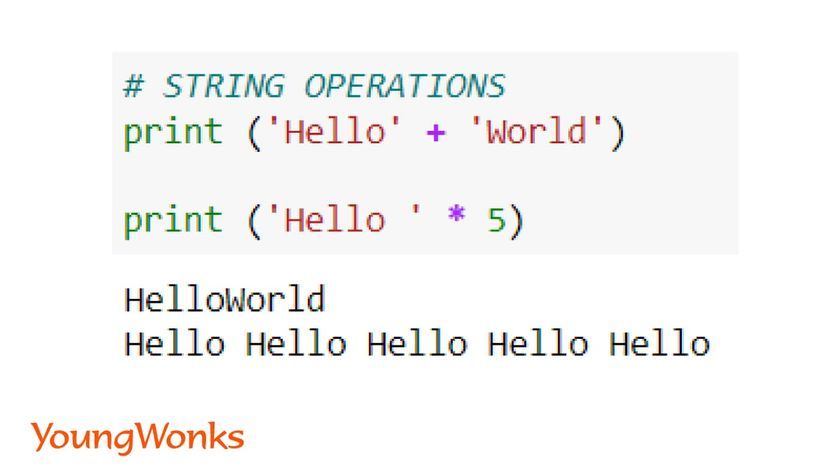
2. Strings Methods
To manipulate strings in Python, we use direct functions. Let us investigate these.
a. The capitalize function returns a copy of the string where the first character is capitalized.
b. The title function titlecases the first character of each word (uppercase).
c. lower function converts a string to lower case.
d. upper is a function that converts a string to upper case.
e. The swapcase function changes upper case to lower case and vice versa.
f. casefold is a function that converts a string to lower case.
g. The replace function replaces the original character with a new one.
h. The find function locates the first position in a string of a specified character.
i. rfind returns the last index where a specified character was found.

3. Methods for Evaluating Strings
These techniques are used to validate the given strings, returns true if they satisfy the method and false otherwise.
a. The isupper function determines whether all of the characters in a string are uppercase.
b. The islower function determines whether all of the characters are lowercase.
c. The startswith function determines whether the string begins with the specified value.
d. The endswith function determines whether the string ends with the specified value.
e. The isalnum function determines whether all characters in a string are alphanumeric.
f. The isalpha function determines whether all characters in a string are alphabets.
g. The isdecimal function determines whether all characters in a string are decimals.
h. The isdigit function determines whether all characters in a string are digits.
i. The isidentifier function determines whether a string is an identifier.
j. The isnumeric function determines whether all characters in a string are numeric.
k. The isprintable function determines whether all characters in a string are printable.
l. The isspace function determines whether all characters in a string are whitespaces.
m. The istitle function determines whether a string conforms to the rules of a title.
Let's look at some examples of these methods.
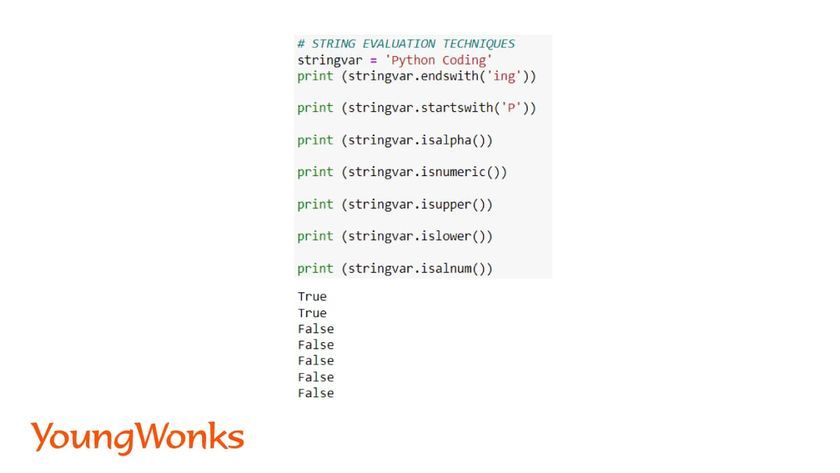
4. String Slicing in Python
Individual characters in a string can be accessed by using an index from the original string. The index begins at 0.
There are two types of indexing: positive indexing and negative indexing. The first letter of a string is always 0 index in positive indexing. Negative indexing is performed from the end of the string and begins at -1.

We use string variables to extract characters from a string, and the index is written in square brackets.
Let's look at the examples in the image below to learn about string slicing.
The first example shows how to extract unique characters.
In the third example, we extract multiple characters at the same time by using the start and end indexes before and after the colon.
Let's take a look at the fifth example: if the index is not specified before or after the colon, it defaults to the start or end index.
The third value in the eighth example is the step to skip certain characters.
The final example reverses a string where the start and end index is the default value.

5. Characters with whitespaces in a Python string
a. The ljust function returns a left justified version of the string that includes whitespaces at the beginning as a suffix.
b. The rjust function returns a right justified version of the string that includes whitespaces at the end as a prefix.
c. The centre function returns the total number of whitespaces at the start of the string.
6. Removing or adding characters from a Python string
a. The strip function removes the specified characters from the beginning and end of a string.
b. The lstrip function removes the specified characters from the beginning of a string.
c. The rstrip function removes the specified characters from the end of a string.

7. String Formatting
This technique was introduced in Python 3 to directly add substrings or variable values to a string. This is used to format long strings. Using the index value, we add the substrings.
Syntax:
stringvar = ‘YoungWonks‘
‘Welcome to {0}‘.format(stringvar)
8. Creating a list from a string
This method converts a string into a list of letters or words.
The split function splits a string at the separator specified and returns a list of words. As an example, consider removing items from a delimiter.
The rsplit function splits a string at the separator specified and returns a list of words.
The splitlines function divides a string into line breaks and returns a list.
join converts a list's elements to strings and returns a new string.
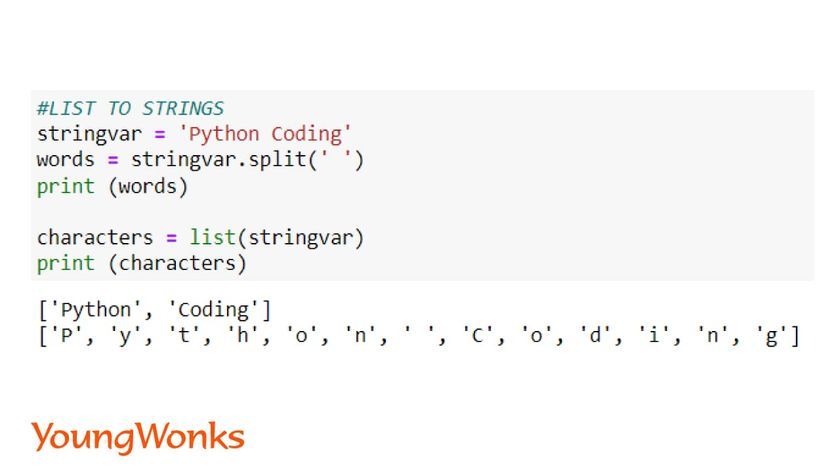
9. Character count
A string can be used to perform various types of count operations.
a. The length function counts the number of letters in a string.
b. The count function returns the number of times a specific character appears in a string.
c. We can also use the collection library and the counter keyword to calculate the number of times each character appears and return a dictionary with the characters as keys and the count as values.
d. The index function searches a string for a given character and returns the first position where it was found.
e. The rindex function searches for a given character and returns the last position where it was found.

10. Additional Python String Methods
a. maketrans searches the entire string for the specified characters. It replaces the specified characters by using the translation table.
b. The format map function uses the dictionary key's value to format specified values in a string.
c. The zfill function begins a string with a specified number of 0 values and continues until the specified number of characters is reached. As an argument, we specify the number of characters required.
d. The encode function encodes the string using the coding specified. UTF-8 is the default encoding.
e. The expandtabs function increases the size of a tab and inserts it between the specified characters in a string.
f. The partition function divides the string into three parts starting with the specified word and returns a tuple.
11. Loops on a string
Strings are iterable, and a loop can be used to extract each character one at a time.
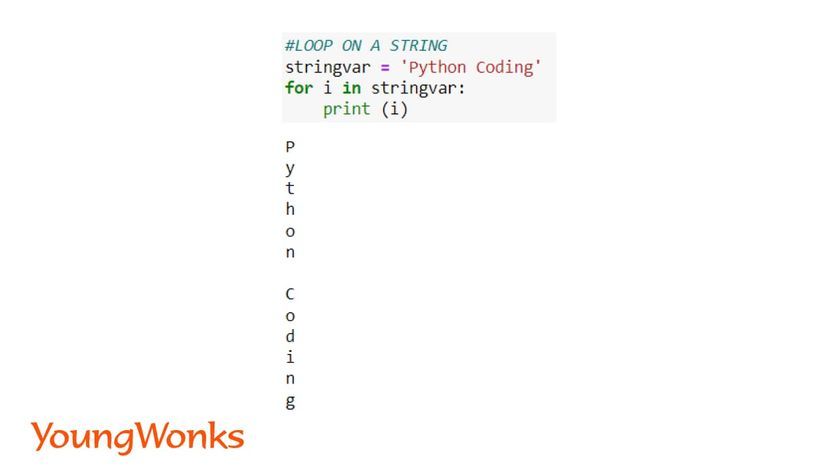
12. Ordinal code
Unicode (specific numbers) are assigned to each character in coding languages.
The ord function returns a character's ordinal number, whereas the chr function returns a character based on the ordinal number.
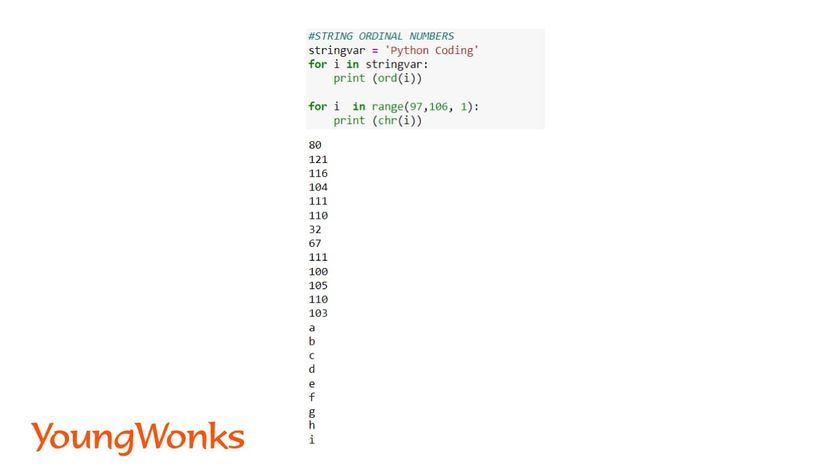
Summary
In this blog, we learned about all the Python string methods. You can now incorporate these into your programmes. In a future blog, we will go over the Python dictionary methods in depth.
Enhance Your Child's Coding Skills with YoungWonks
To further elevate your child's programming expertise, especially in Python, exploring dedicated courses is invaluable. At Coding Classes for Kids, we offer a comprehensive curriculum tailored to young minds. Specifically, our Python Coding Classes for Kids are designed to unravel the complexities of Python in an engaging and understandable manner. Beyond Python, we also offer courses in Raspberry Pi, Arduino and Game Development Coding Classes, providing a robust foundation in coding and hardware that empowers students to build, innovate, and create projects of their own imagination.
*Contributors: Written by Aayushi Jayaswal; Lead image by Shivendra Singh

